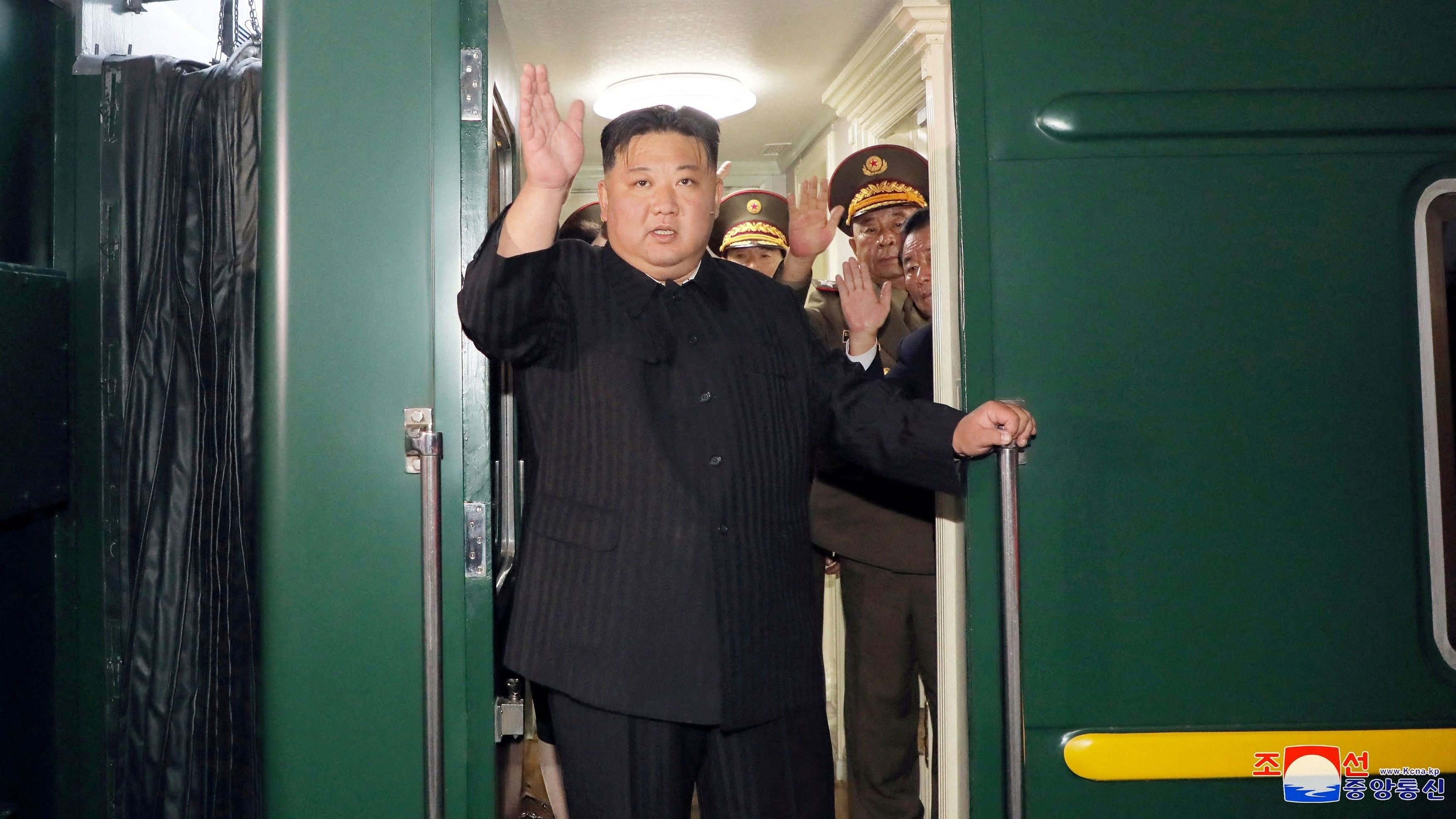
North Korean leader Kim Jong Un waves from a private train as he departs Pyongyang, North Korea, to visit Russia.
Credit: Reuters Photo
When outside intelligence officials seek evidence of North Korean leader Kim Jong Un leaving on a trip abroad such as his journey to Russia this week to meet with President Vladimir Putin they always look for the whereabouts of a train painted a drab green.
One such train was spotted Monday heading north, near where the borders of North Korea, Russia and China meet. It was moving in the direction of Vladivostok, where Putin is attending an economic forum. On Tuesday, North Korean state media confirmed that Kim had indeed left Pyongyang, the North’s capital, for Russia by train.
The green train that officials look for is the special bulletproof one that Kim and his father and grandfather, who ruled North Korea before him have used to visit China, Russia or the former Soviet Union. Family members were said to lack confidence that they could make a safe long-distance trip using one of their country’s decrepit fleet of old Soviet-era passenger jets.
Although much about Kim’s latest journey remains a mystery, here is what we know about the train:
More powerful than a speeding bullet, but much slower
Much of what is known about the train comes from intelligence reports, recollections of officials permitted to travel on board in previous eras and rare state news media footage.
There are believed to be at least 90 high-security carriages at the leader’s disposal, according to a 2009 South Korea news report that relied on classified information. According to the report, written during the era of Kim’s father, Kim Jong Il, three trains operate each time the leader travels: an advance security train, the leader’s train and a third carrying additional bodyguards and supplies.
Each of the carriages is bulletproof, making them thousands of pounds heavier than average. That additional weight translates to a slow ride. The trains are estimated to reach a maximum speed of just 37 mph.
In Kim Jong Il’s time, according to the 2009 report, 100 security officers traveled in the advance train, searching stations for bombs and other threats and testing the safety of the track. Additionally, military helicopters and airplanes would fly overhead to provide more security.
Twenty train stations have been built across North Korea just for the leader’s personal use, according to the report.
All the comforts of home
North Korea’s state news media occasionally covered the leaders from inside the train, offering a rare glimpse at some of the many specialized cars.
When Kim Jong Un made his first state visit to China in 2018, he met a senior Chinese official who boarded his train in a carriage lined with thick pink sofas.
In 2015, Kim Jong Un was seen seated at a long white table in what appeared to be a conference room. In a similar video from 2011, his father, Kim Jong Il, is seen holding court in the same compartment. In the older video, a flat-screen television is clearly visible, and in the more recent one, a laptop computer can be seen.
In footage of the elder Kim’s trips, the leader is seen in an audience car with plush seats; leading a meeting in a dining car; and attending a banquet in a car paneled in dark wood. In that footage, Kim is seated at a table filled with food as entertainers perform in tuxedos and evening gowns.
The former leader’s office car, including a desk and computer, is preserved as a museum exhibit at the Kumsusan Palace of the Sun, Kim Jong Il’s mausoleum in Pyongyang.
Lobster, wine and ‘lady conductors’
Kim Jong Il was rumored to have had a fear of flying and preferred to travel on his train, which was outfitted with modern communications technology and a large staff that catered to his whims.
“It was possible to order any dish of Russian, Chinese, Korean, Japanese and French cuisine,” wrote Konstantin Pulikovsky, a Russian official who traveled with the former leader during a 2011 trip through Russia.
Kim insisted that live lobster and other fresh delicacies be delivered to the train as it crossed Siberia on trips to Russia. Cases of Bordeaux and Burgundy wines were flown in from Paris, Pulikovsky recounted in his memoir of the trip, “Orient Express.”
When bored, Kim relied on a group of female entertainers known as “lady conductors” to serenade him in Korean and Russian.
It is unknown what his son, Kim Jong Un, does for nourishment and entertainment while on board, but the younger Kim’s appetite is known to rival his father’s. He reportedly prefers Swiss cheese, Cristal Champagne and Hennessy cognac.
Tragedies on the tracks
The train has been at the center of several tragic events in modern North Korean history.
More than 160 people were killed in Ryongchon, near the Chinese border, in April 2004, when trains laden with combustible material exploded because of a collision or an electrical malfunction.
There were initial rumors that the explosion was part of an attempt on Kim Jong Il’s life because the leader’s train had passed through the town hours earlier.
According to the state news media, he would later die aboard his train after a heart attack in December 2011.
After he became leader, Kim Jong Un visited China four times and Vietnam once all by train. He also visited Russia by train and met Putin in 2019.